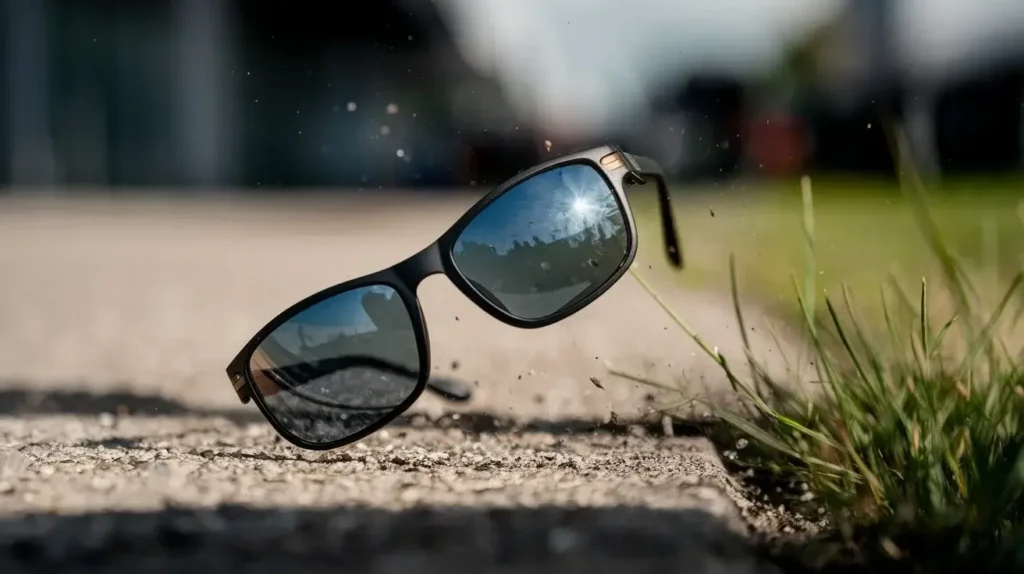Sunglasses Lens Materials: Which One’s Right for You?
When choosing sunglasses, the lens material is just as important as the style. The right material can affect everything from how comfortable your shades feel to how well they protect your eyes. Whether you’re out in the sun for long periods or need something more durable for daily use, knowing the differences in lens materials helps you make a smarter choice.
In this article, we’ll break down the most common lens materials, weighing their pros and cons so you can find the best fit for your needs. Whether you prioritize clarity, durability, or weight, each material has its own strengths.
Our goal is to guide you through the key points so you can confidently choose the right lenses for your lifestyle. So, before you make your next sunglasses purchase, let’s take a closer look at what you should consider.
Contents
The Big Players: Common Lens Materials
Let’s start with the heavy hitters in the sunglasses world. These are the materials you’ll come across most often when shopping for your next pair of sunnies:
- Glass: The OG of lens materials
- CR-39 Plastic: The lightweight contender
- Polycarbonate: The tough guy
- Trivex: The new kid on the block
- High-index plastic: The slim and trim option
Now, let’s break these down and see what each brings to the table.
Breaking It Down: Pros and Cons of Each Material
1. Glass
Ah, glass. It’s been around forever, and for good reason.

Pros
- Crystal clear optics
- Scratch-resistant
- Great for prescription lenses
Cons
- Heavy (your nose will feel it after a while)
- Can shatter (not ideal for sports or clumsy folks)
- Pricier than some alternatives
Glass lenses are like that classic car in your garage – beautiful, high-quality, but maybe not the most practical for everyday use.
Recommendation: If clarity is your top priority and you’re gentle with your gear, check out these Ray-Ban Aviators with glass lenses. They’re a classic for a reason.
2. CR-39 Plastic
CR-39 is the plastic that started it all. It’s been a staple in the eyewear industry since the 1940s.

Pros
- Lightweight
- Good optical clarity
- Affordable
Cons
- Not as impact-resistant as polycarbonate
- Can scratch more easily than glass
CR-39 is like your trusty pair of jeans – comfortable, gets the job done, and easy on the wallet.
Recommendation: For a budget-friendly option with CR-39 lenses, try the Flying Fisherman Polarized Sunglasses. Great for outdoor sports without breaking the bank.
3. Polycarbonate
If your sunglasses could hit the gym, they’d build polycarbonate muscles.

Pros
- Extremely impact-resistant (great for sports)
- Lightweight
- Built-in UV protection
Cons
- Not as scratch-resistant as glass
- Slightly less clear than glass or CR-39
Polycarbonate is your adventure buddy – tough, reliable, and ready for anything.
Recommendation: For the active guys out there, the Maui Jim rimless sunglasses with polycarbonate lenses are hard to beat.
4. Trivex
Trivex is the new cool kid that’s giving polycarbonate a run for its money.
Pros
- Even lighter than polycarbonate
- Excellent impact resistance
- Better optical clarity than polycarbonate
Cons
- Can be pricier than other plastics
- Not as widely available
Trivex is like that high-tech running shoe – lightweight, high-performance, but might cost you a bit more.
5. High-Index Plastic
For those of you with stronger prescriptions, high-index plastic is your new best friend.
Pros
- Thinner and lighter than standard plastic lenses
- Great for strong prescriptions
- Good UV protection
Cons
- More expensive than standard plastic
- Can have more glare (but usually comes with anti-reflective coating)
High-index plastic is like tailored clothing for your eyes – sleek, customized, and a bit more luxurious.
Special Considerations
Alright, now that we’ve covered the basics, let’s talk about some special situations you might find yourself in.
Prescription Lenses
If you’re part of the glasses-wearing club (welcome, fellow four-eyes!), your choice of lens material becomes even more crucial. Here’s the lowdown:
- Glass: Great for clarity, but heavy. Best for mild prescriptions.
- CR-39: Good all-rounder, works well for most prescriptions.
- Polycarbonate: Ideal for stronger prescriptions and active lifestyles.
- High-index plastic: The go-to for very strong prescriptions.
Remember, your optometrist is your friend here. They can guide you to the best material based on your specific needs.
Sports and Active Lifestyles
If you’re the type who’s always on the move, your sunglasses need to keep up. Here’s what to look for:
- Impact resistance: Polycarbonate or Trivex are your best bets.
- Lightweight: Again, polycarbonate or Trivex win here.
- UV protection: Not all lenses offer 100% UV protection. Always check the specs before buying.
Fashion vs. Function: Balancing Looks and Performance
Look, we get it. You want to look good AND see clearly. The good news? You can have both. Here’s how to strike that balance:
- For everyday wear: CR-39 or polycarbonate lenses in stylish frames offer a good mix of performance and looks.
- For special occasions: Glass lenses in premium frames can give you that extra touch of class.
- For active days: Stick with polycarbonate or Trivex in sporty frames.
Remember, the most stylish sunglasses are the ones that fit your face shape and personal style. Don’t be afraid to try on different pairs!
Common Misconceptions Debunked
While we’re at it, let’s clear up a few myths:
- “Glass lenses are always clearer than plastic.”
Not necessarily. High-quality plastic lenses can be just as clear as glass.
- “Polarized lenses block all UV rays.”
Polarization and UV protection are separate features. Always check for UV protection specifically.
- “More expensive always means better quality.”
While price can be an indicator, it’s not the only factor. Always consider your specific needs.
Making Your Choice: A Quick Decision Guide
Feeling a bit overwhelmed? Don’t worry, we’ve got you covered. Here’s a quick guide to help you choose:
For everyday wear:
- Polycarbonate or CR-39 lenses
- Consider polarization if you’re often in bright environments
For sports and active lifestyles:
- Polycarbonate or Trivex lenses
- Impact-resistant frames
- Polarized if you’re around water or snow
For fashion-forward looks:
- Glass or high-index plastic for premium frames
- Consider anti-reflective coatings for that extra touch
For strong prescriptions:
- High-index plastic or polycarbonate
- Discuss options with your optometrist
Budget considerations:
- CR-39 is typically the most affordable
- Polycarbonate offers good value for money
- Glass and high-index plastics are usually pricier
Remember, the best sunglasses are the ones that fit your lifestyle, protect your eyes, and make you feel awesome when you wear them.
Frequently Asked Questions
Q: Can I get prescription lenses in any material?
A: While most materials can be used for prescriptions, some are better suited for stronger prescriptions. Your optometrist can guide you to the best option.
Q: Are expensive sunglasses really worth it?
A: Higher price often (but not always) indicates better quality materials and construction. However, you can find good quality at various price points. Focus on finding sunglasses that meet your needs and provide proper eye protection.
Q: Are glass lenses more environmentally friendly than plastic ones?
A: Glass is more recyclable than most plastic lens materials. However, plastic lenses are more durable and less likely to break, potentially lasting longer. The most eco-friendly option is to choose quality sunglasses that will last for years.
Q: Can lens material affect the weight distribution of sunglasses?
A: Yes. Heavier materials like glass can make sunglasses front-heavy, while lighter materials like polycarbonate allow for more balanced designs. This can impact comfort during extended wear.
Q: How do different lens materials affect the overall cost of sunglasses?
A: Generally, CR-39 is the most affordable, followed by polycarbonate. High-index plastics and glass tend to be pricier. Trivex often falls between polycarbonate and high-index in terms of cost.
Q: Can the choice of lens material impact the variety of tints available?
A: Most materials can accept a wide range of tints. However, polycarbonate and Trivex may not achieve as dark a tint as glass or CR-39 due to their molecular structure.
Q: How do different lens materials handle anti-reflective coatings?
A: All materials can receive anti-reflective coatings, but they may adhere differently. High-index plastics often benefit most from these coatings due to their higher refractive index.
Q: How do different lens materials affect the clarity of polarized lenses?
A: Glass typically offers the clearest polarized vision, followed closely by CR-39. Polycarbonate and Trivex polarized lenses may have slightly less clarity but offer better impact resistance.
There you have it, folks – your complete guide to sunglasses lens materials. Now go forth and find your perfect pair of shades!